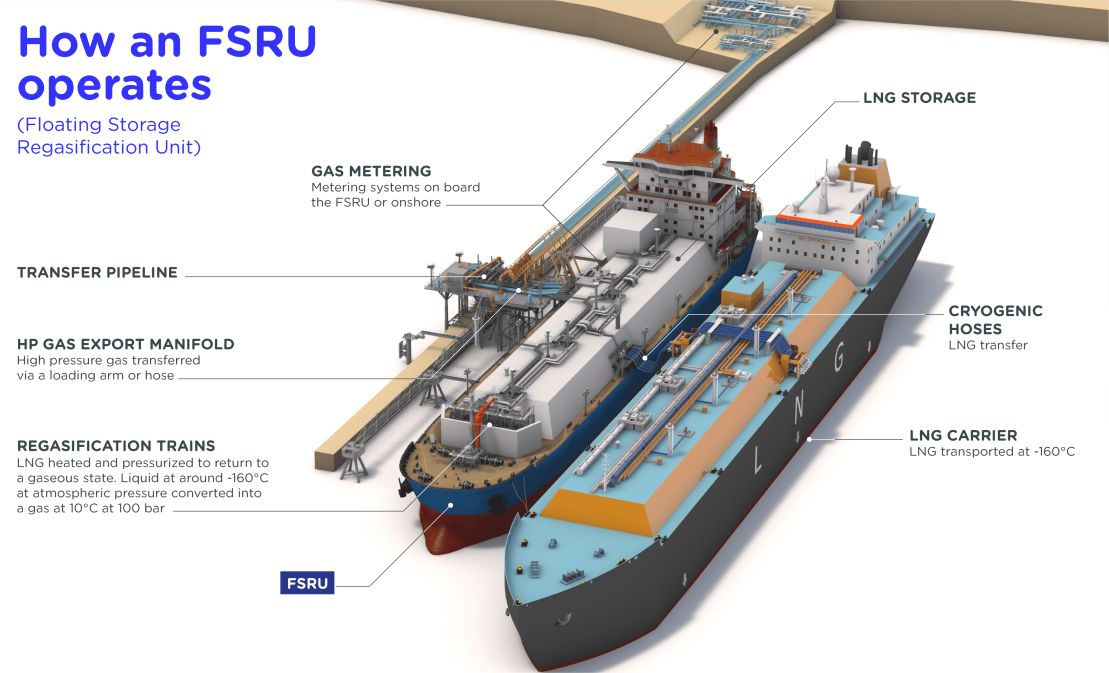How an FSRU operates

Regasification is the process of converting liquefied natural gas (LNG) back into its gaseous form. In the context of Floating Storage and Regasification Units (FSRUs), regasification refers to the process of converting LNG that has been stored on board the vessel back into natural gas, which can then be sent to shore via pipeline for use in homes, businesses, and industries.
The main purpose of the regasification plant is to pressurize and vaporize LNG, allowing distribution to an onshore pipeline. At the plant's inlet, LNG from the ship’s cargo tanks is delivered by the regas feed pumps or cargo pumps, which are equipped in the vessel, at a pressure of approximately 5.5 bar(g) and -160°C. The outlet from the regasification plant is designed in order to ensure a send out rate of between 50 ~ 1,000mmscfd at a pressure range of 90 ~ 103 bar and a temperature of 5°C. The regasification plant consists of vaporiser trains.
The regas trains are located in the regas unit space, in the foreship area, with the intermediate glycol water loop and seawater systems located in the forward pump room. The regas plant can use four sea water pumps, located in the forward pump room, to provide the heat for vaporising LNG and heating the NG to the required temperature. Because of safety and operational reasons, sea water is not used directly as a heating medium, the glycol water is heated by sea water in an intermediate loop. In the initial stage of the regasification, LNG will be supplied via the submerged cargo tank pumps to a suction drum located on the trunk deck. The NG send-out temperature of 5°C is designed based on the sea water temperature of 14°C. In the low sea water temperature conditions, 8 ~ 14°C, the partial glycol water is heated by glycol water steam heaters using high pressure steam (approximately 15 bar(g)) in the glycol water steam heaters.
Each of the regas trains are identical, consisting of:
• One identical LNG booster pump. • One HP LNG vaporiser • One NG heater. The LNG feed from the regas feed pumps is directed to the booster pump suction pots where the pressure is increased. Then, the LNG flows to the HP LNG vaporiser which is fitted to evaporate the LNG using the glycol water via a sea water heating medium. LNG at a pressure slightly higher than the send-out pressure of the NG to shore, enters the HP LNG vaporiser where evaporation of the LNG takes place.
At nominal design conditions, the LNG will be heated from approximately -160°C/-150°C to above approximately -30°C; the NG then flows to the natural gas heater. The natural gas heater is installed downstream of the HP LNG vaporiser to heat the NG to achieve the correct send-out conditions. The NG heater unit uses the glycol water as a heating medium to raise the temperature of the NG. The export natural gas vapour is above 5°C. The high pressure NG from regas plant trains is routed to the HP manifold and is exported to the onshore pipeline after regulating its pressure by the back pressure control valves. The production rate of high pressure NG is measured by the large gas metering unit for the regas plant trains at the HP manifold. The glycol water heating module, which delivers heat energy to the regas plant module from sea water, is separated from the regas plant module and is located in the forward pump room, with the glycol water steam heaters in the bosun’s store.
The design of an FSRU can be different from that of a traditional ship, as it has specific requirements and functions that need to be taken into consideration. FSRUs are designed to receive, store, and regasify liquefied natural gas (LNG) for delivery to onshore gas pipelines or for use as fuel for ships.
Some of the design differences that may be seen on an FSRU include:
Storage Capacity: An FSRU needs to have a large storage capacity to hold LNG, which is typically stored in cryogenic tanks.
Regasification Equipment: FSRUs have specialized regasification equipment to convert LNG back into natural gas, which can be transported via pipeline or used as fuel.
LNG Offloading Equipment: FSRUs have specialized equipment for the offloading of LNG from transport vessels, which can include transfer arms or hoses.
Environmental Considerations: FSRUs are designed with consideration for the marine environment, with features such as ballast water treatment systems, hull coatings to reduce drag and emissions, and noise and vibration control.
Overall, the design of an FSRU is tailored to its specific purpose of receiving, storing, and regasifying LNG for transport or use.
